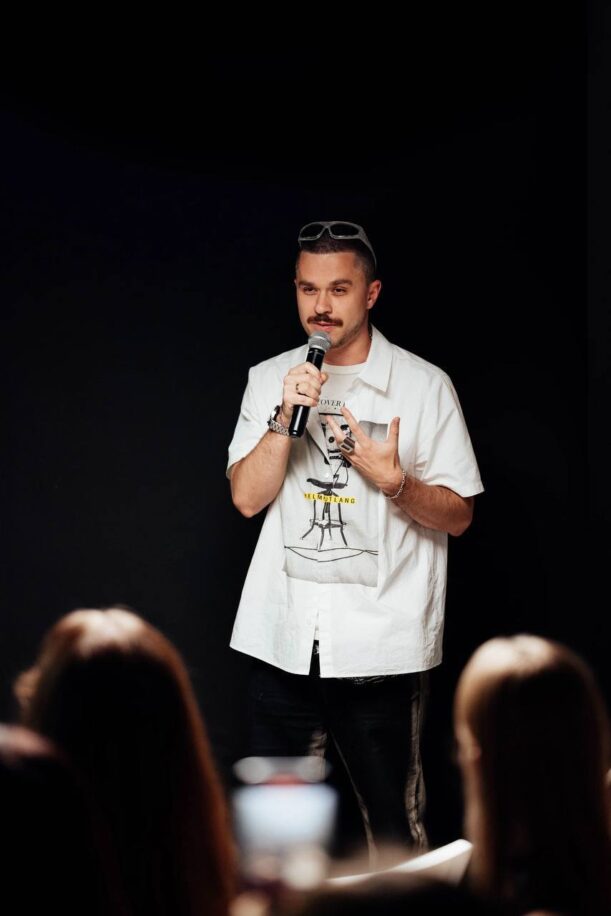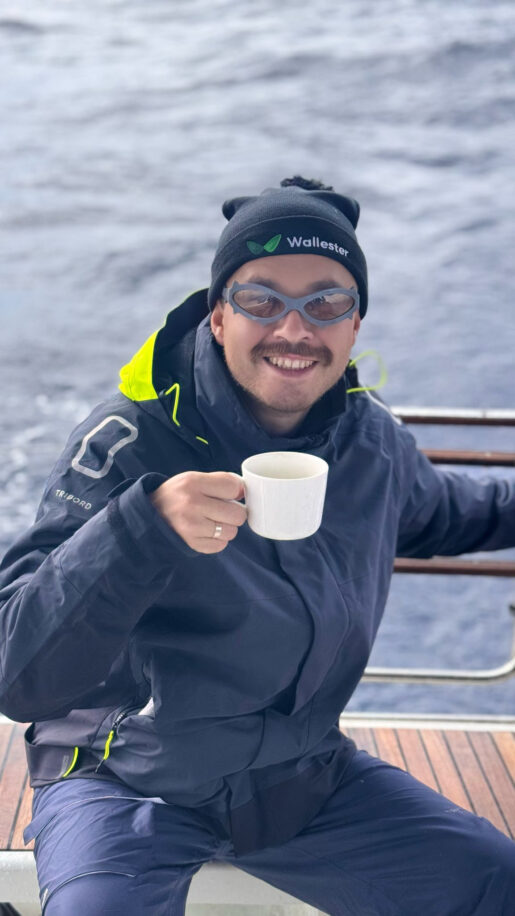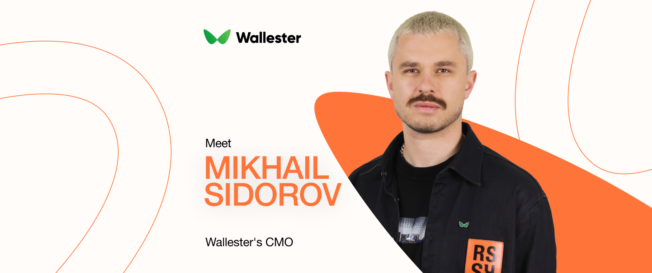Mikhail Sidorov knows how to build things. As the founder of two multiple award-winningmarketing agencies, he’s spent the last 15+ years helping global brands craft culture-forward campaigns, grow market share, and turn marketing from a cost centre into a growth engine. Now, as Chief Marketing Officer at Wallester, he’s applying that same founder mindset to one of Europe’s most ambitious fintech platforms.
We sat down with Mikhail to talk about his transition to in-house leadership, how to design marketing organisations that actually perform, and why most B2B marketers are still measuring the wrong things, and showing up on the wrong channels.
“I chose to make a Tier-1 brand in the fintech industry.”
Mikhail Sidorov
Interviewer:
You’ve had a pretty unconventional career. Walk us through how you went from running your own agency to leading marketing at one of Europe’s fastest-growing fintech platforms.
Mikhail Sidorov:
Sure, although to me, it’s been a pretty natural evolution. I’ve spent the last 15+ years in marketing. I built my first digital marketing agency from the ground up. What started as a small team quickly grew into a full operation working with global brands — like NTT Data, Yandex, VK, Adidas Originals and much much more.
A few years ago, I relocated to Lisbon and had to leave the agency behind. That’s when I launched Understand, a marketing agency focused on tech companies and startups. We worked with numerous global brands and helped them translate complex products into meaningful narratives and campaigns.
That’s also where Wallester came in. Sergei Astafjev and Dmitri Logvinenko (Wallester’s co-founders) reached out and said, “We want to build what you know how to build. Can you do it inside our company?” It was clear that this was the right next step.
Now I’m full-time at Wallester, and I get to apply everything I’ve learned about building teams, brands, marketing and growth systems, but at scale and with real focus.
“In-house isn’t a downgrade. It’s where the real leverage is.”
Mikhail Sidorov

Interviewer:
Was it a tough transition, moving from running your own agency to working inside a company?
Mikhail Sidorov:
Not at all. Most people assume it’s about giving up freedom, but for me, it’s about gaining focus.
Inside a company like Wallester, I get to go deep. I can own the whole arc of a brand, not just the campaigns, but the category we’re shaping.
Additionally, agency life teaches you to be both scrappy and strategic simultaneously. You get used to delivering under constraints. That’s a superpower in fintech, where speed, compliance, and product cycles all collide.
“If your KPIs don’t have owners and deadlines, they’re just hopes.”
Mikhail Sidorov
Interviewer:
Let’s talk about execution. You’ve been vocal about marketers measuring the wrong things. What are you doing differently at Wallester?
Mikhail Sidorov:
Building the proper measurement framework is one of the most complex parts of marketing leadership. Most teams track activity, not impact. They count impressions, clicks, engagement, things that feel good on slides but don’t move the business forward.
So at Wallester, we’ve simplified things down to three rules.
First: every KPI has a name and a deadline. If nobody owns it, and there’s no timeline? It’s not a KPI, it’s just wishful thinking.
Second: impact over activity. We’re shifting away from vanity metrics like impressions or reach. Instead, we look at things like cost per enterprise lead or how much qualified pipeline we’re generating because that’s what actually moves the needle.
And third: clear accountability. The creative team owns brand consistency. Performance owns conversions. Everyone knows what they’re responsible for and how it ties back to growth. No confusion and no overlaps. It sounds basic, but when you get this right, everything runs more efficiently and effectively.
This structure is already changing how we think. Marketing isn’t art therapy. It’s a revenue engine.
“Most B2B marketers are asleep at the wheel. Especially on social media.”
Mikhail Sidorov
Interviewer:
You’ve said B2B marketers are “sleeping on Instagram.” What do you mean by that?
Mikhail Sidorov:
It drives me crazy that most B2B teams still believe LinkedIn is the only place “real business” happens. It’s not.
Your target, whether it’s a CFO, founder, or procurement head, is still a person. They’re scrolling Instagram at lunch. They’re watching TikToks at night. They check Reels between meetings. The notion that serious decisions can only be made on serious platforms is nonsense.
At Wallester, we run Meta campaigns targeting CFOs and finance leaders. We use Reels to demo card features. Stories to show off our API integrations. The result? Lower cost per qualified lead compared to LinkedIn. Three times the engagement.
The lesson is simple: go where attention lives, not where you think it’s supposed to be. But respect the language of each platform. Don’t bring LinkedIn energy to TikTok. Don’t post slide decks on Instagram. Adapt or stay invisible
“Performance gets you this quarter. Brand gets you next year.”
Mikhail Sidorov
Interviewer:
Where do you draw the line between brand and performance? Or is that another false binary?
Mikhail Sidorov:
It’s not a binary; it’s a timeline.
Early stage (0–3 years)? Go all-in on performance. You need revenue to survive. Direct response, paid ads, partner content, and ensure you track every cent spent.
But once you have traction, you need to switch gears. Because performance channels have ceilings. Your CAC climbs. Your audience fatigue increases. Competitors copy your ads. Growth stalls.
That’s when the brand becomes your saviour. Tier-one fintechs don’t chase leads; leads chase them. That comes from reputation, positioning, and building mental availability.
At Wallester, we made that shift once our unit economics stabilised. We still invest in performance, but we’re now allocating 30–60% of the budget to the brand, depending on the campaign cycle. And it’s paying off, not instantly, but predictably over time.
“You don’t need ‘more content.’ You need better strategy.”
Mikhail Sidorov
Interviewer:
Wallester has a broad addressable market, including media buying, real estate, logistics, travel, and more. How do you avoid watering down your message?
Mikhail Sidorov:
You start with one truth: nobody cares about your product.
They care about their pain. We map every segment, including media buyers, CFOs, real estate developers, and fleet managers, and align the messaging to their specific needs and challenges. We’re building message stacks per industry. Not feature lists. Not generic benefits. Real-world use cases with emotional pain points.
The worst thing you can do is one-size-fits-all messaging. It’s comfortable but invisible
“Manage your energy, not just your calendar.”
Mikhail Sidorov
Interviewer:
Switching gears, how do you manage the workload? Fintech marketing moves fast. How do you stay effective?
Mikhail Sidorov:
I spent eight years trying to perfect time management. Colour-coded calendars. Task systems. Productivity apps.
I used to obsess over time management, with perfect calendars, colour-coded blocks, and every productivity app imaginable. However, none of it really made a difference. What actually changed everything for me was realising it’s not about managing your time, it’s about managing your energy.
So here’s how I work now, in real life:
I’m up at 6 AM. Gym first, consistently. Not because I’m a fitness freak, but because when your body’s working, your brain works better too. Physical energy = operational energy.
Emails? They get two windows a day. That’s it. If you let Slack and email run wild, you’ll look up at 4 PM and realise you’ve done nothing strategic. Communication needs boundaries.
Sunday is planning day. I map out the entire week; what requires my full attention goes in the morning slots, and admin and calls go in the low-energy zones, such as after lunch.
Each day, I focus on two or three real priorities. Start with the team tasks, unblock whoever is waiting on me, and then shift into deeper, focused work.
And the tools? They have to work with me, not against me. I use Todoist to quickly capture tasks, ClickUp to manage team flow, and Notion to keep the calendar under control. If your tools drain your energy, they’re not helping; they’re slowing you down.
Structure gives me freedom. That’s what lets me actually get things done.
“An intense sailing trip taught me more about leadership than any book.”
Mikhail Sidorov

Interviewer:
Before you joined Wallester, you went on a sailing trip. What was that all about?
Mikhail Sidorov:
Yeah, I had planned a two-week sailing trip from Tenerife to Madeira to Lisbon before taking the role. It wasn’t a vacation. It was survival. You sleep four hours, then do three-hour shifts on deck. It’s physical, it’s mental, and it pushes every boundary.
But that’s where I learned what leadership actually looks like under pressure. No slides. No Slack. Just responsibility, communication, and weather you can’t control.
Also, yes, I wore Wallester gear the whole time. So technically, my first activation was in the middle of the Atlantic.
Final Thoughts
Mikhail Sidorov:
Most marketers today are playing not to lose. That’s a mistake. The ones who win, in fintech or anywhere, are the ones who make bold bets, build real systems, and understand that marketing isn’t about channels or creatives. It’s about changing behaviour at scale.


